Bishop of Durham
| Bishop of Durham | |
|---|---|
| Bishopric | |
| anglican | |
 | |
|
Incumbent: Paul Butler | |
| Province | York |
| Diocese | Durham |
| Cathedral |
Durham Cathedral (since 995) St Mary and St Cuthbert, Chester-le-Street (882–995) Lindisfarne (635–875) |
| First incumbent |
Aidan Aldhun (first Bishop of Durham) |
| Formation |
635 (at Lindisfanre) 995 (translation to Durham) |
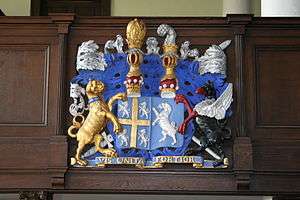
The Bishop of Durham is the Anglican bishop responsible for the Diocese of Durham in the Province of York. The diocese is one of the oldest in England and its bishop is a member of the House of Lords. Paul Butler has been the Bishop of Durham since his election was confirmed at York Minster on 20 January 2014.[1] The previous bishop was Justin Welby, Archbishop of Canterbury. The bishop is one of two (the other is the Bishop of Bath and Wells) who escort the sovereign at the coronation.
He is officially styled The Right Reverend Father in God, (Christian Name), by Divine Providence Lord Bishop of Durham, but this full title is rarely used. In signatures, the bishop's family name is replaced by Dunelm, from the Latin name for Durham (the Latinised form of Old English Dunholm). In the past, Bishops of Durham varied their signatures between Dunelm and the French Duresm. Prior to 1836, the Bishop of Durham was a prince-bishop and had significant temporal powers over the Liberty of Durham and later the County Palatine of Durham.
The bishop lived in Durham Castle from its construction in the 11th century. In 1832, Auckland Castle became the official residence of the Bishops of Durham until July 2012 when ownership of the castle was transferred over to the Auckland Castle Trust, a charitable foundation with the aim of beginning a major restoration of the grounds and castle and creating permanent exhibitions on the history of Christianity in Britain and the North East.[2] The bishop continues to have offices in Auckland Castle but no longer resides there.[3]
History
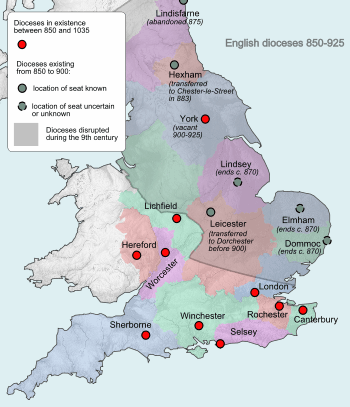
The Bishop of Lindisfarne is an episcopal title which takes its name after the tidal island of Lindisfarne, which lies just off the northeast coast of Northumberland, England. The title was first used by the Anglo-Saxons between the 7th and 10th centuries. In the reign of Æthelstan (924–939) the bishop was known as the Bishop of Chester-le-Street[4] or the Bishop of the Church of St Cuthbert. According to George Molyneaux, "it was in all probability the greatest landholder between the Tees and the Tyne".[5] It is now used by the Roman Catholic Church for a titular see.
The Anglo-Saxon bishops of Lindisfarne were ordinaries of several early medieval episcopal sees (and dioceses) in Northumbria and pre-Conquest England. The first such see was founded at Lindisfarne in 635 by Saint Aidan.[6]
From the 7th century onwards, in addition to his spiritual authority, the Bishops of Lindisfarne, and then Durham, also acted as the civil ruler of the region as the lord of the liberty of Durham, with local authority equal to that of the king. The bishop appointed all local officials and maintained his own court. After the Norman Conquest, this power was retained by the bishop and was eventually recognised with the designation of the region as the County Palatine of Durham. As holder of this office, the bishop was titled a prince-bishop and considered the equivalent of an earl. Except for a brief period of suppression during the Glorious Revolution, the bishopric retained this temporal power until it was abolished by the Durham (County Palatine) Act 1836.
List of bishops
Early Medieval bishops
| Bishops of Lindisfarne | |||
|---|---|---|---|
| From | Until | Incumbent | Notes |
| 635 | 651 | Aidan | Saint Aidan. |
| 651 | 661 | Finan | Saint Finan. |
| 661 | 664 | Colmán | Saint Colmán. |
| 664 | Tuda | Saint Tuda. | |
| In 664 the diocese was merged to York by Wilfrid (who succeeded Tuda following his death), leaving one large diocese in the large northern Kingdom of Northumbria. | |||
| The diocese was reinstated in 678 by Theodore of Tarsus, Archbishop of Canterbury following Wilfrid's banishment from Northumbria by King King Ecgfrith. Its new seat was initially (at least in part) at Hexham (until a new diocese was created there in 680). | |||
| 678 | 685 | Eata of Hexham | Saint Eata. |
| 685 | 687 | Cuthbert | Saint Cuthbert. |
| 688 | 698 | Eadberht | Saint Eadberht. |
| 698 | 721 | Eadfrith | Saint Eadfrith. |
| 721 | 740 | Æthelwold | Saint Æthelwold. |
| 740 | 780 | Cynewulf | |
| 780 | 803 | Higbald | |
| 803 | 821 | Egbert | |
| 821 | 830 | Egfrid | |
| 830 | 845 | Ecgred | |
| 845 | 854 | Eanbert | |
| 854 | 875 | Eardulf | |
| The monks of Lindisfarne fled from the Danes in 875 along with the ancient remains of Saint Cuthbert and there was no seat of the Bishop of Lindisfarne for seven years. In 882 Eardulf and his monks settled in Chester-le-Street, sometimes known as Cuncacestre, and the seat of the Bishop and diocese of Lindisfarne was based there until 995. | |||
| Bishops of Lindisfarne (at Chester-le-Street) | |||
| From | Until | Incumbent | Notes |
| 882 | 900 | Eardulf | |
| 900 | 915 | Cutheard | |
| 915 | 928 | Tilred | |
| 928 | 944 | Wilgred | |
| 944 | 947 | Uchtred | |
| 947 | Sexhelm | ||
| 947 | 968 | Aldred | |
| 968 | 990 | Ælfsige | Called "Bishop of St Cuthbert". |
| 990 | 995 | Aldhun | Moved the see & diocese to Durham. |
| In 995, the King had paid the Danegeld to the Danish and Norwegian Kings and peace was restored. Aldhun was on his way to reestablish the see at Lindisfarne when he received a divine vision that the body of St Cuthbert should be laid to rest in Durham. The see and diocese of Lindisfarne was moved to Durham and the bishop's title became Bishop of Durham. | |||
| Source(s):[7] | |||
| Bishops of Durham | |||
| From | Until | Incumbent | Notes |
| 995 | 1018 | Aldhun | previously Bishop of Lindisfarne. |
| 1021 | 1041 | Edmund | |
| 1041 | 1042 | Eadred | |
| 1042 | 1056 | Æthelric | |
| 1056 | 1071 | Æthelwine | |
| Source(s):[8] | |||
Pre-Reformation prince-bishops
| Bishops of Durham | |||
|---|---|---|---|
| From | Until | Incumbent | Notes |
| 1071 | 1080 | William Walcher | |
| 1081 | 1096 | William de St-Calais | |
| 1099 | 1128 | Ranulf Flambard | |
| 1133 | 1140 | Geoffrey Rufus | |
| 1141 | 1143 | William Cumin | |
| 1143 | 1153 | William of St. Barbara | |
| 1153 | 1195 | Hugh de Puiset | |
| 1197 | 1208 | Philip of Poitou | |
| 1209 | 1213 | Richard Poore | Election quashed by Pope Innocent III (who was quarrelling with King John); later elected and consecrated. |
| 1214 | 1214 | John de Gray | Died before consecration. |
| 1215 | 1215 | Morgan | Election quashed. |
| 1217 | 1226 | Richard Marsh | |
| 1226 | 1227 | William Scot | Election quashed. |
| 1229 | 1237 | Richard Poore | Translated from Salisbury. |
| 1237 | 1240 | Thomas de Melsonby | Resigned before consecration. |
| 1241 | 1249 | Nicholas Farnham | |
| 1249 | 1260 | Walter of Kirkham | |
| 1260 | 1274 | Robert Stitchill | |
| 1274 | 1283 | Robert of Holy Island | |
| 1284 | 1310 | Antony Bek | Also Titular Patriarch of Jerusalem from 1306 to 1311 (the only English person ever to hold this post). |
| 1311 | 1316 | Richard Kellaw | |
| 1318 | 1333 | Lewis de Beaumont | |
| 1333 | 1345 | Richard de Bury | |
| 1345 | 1381 | Thomas Hatfield | |
| 1382 | 1388 | John Fordham | Translated to Ely. |
| 1388 | 1406 | Walter Skirlaw | Translated from Bath & Wells. |
| 1406 | 1437 | Thomas Langley | |
| 1437 | 1457 | Robert Neville | Translated from Salisbury |
| 1457 | 1476 | Lawrence Booth | Translated to York. |
| 1476 | 1483 | William Dudley | |
| 1484 | 1494 | John Sherwood | |
| 1494 | 1501 | Richard Foxe | Translated from Bath & Wells, later translated to Winchester. |
| 1502 | 1505 | William Senhouse | Translated from Carlisle. |
| 1507 | 1508 | Christopher Bainbridge | Translated to York. |
| 1509 | 1523 | Thomas Ruthall | |
| 1523 | 1529 | Thomas Wolsey | Archbishop of York. Held Durham in commendam. |
| 1530 | 1559 | Cuthbert Tunstall | Translated from London. |
| Source(s):[8] | |||
Post-Reformation prince-bishops
| Bishops of Durham | |||
|---|---|---|---|
| From | Until | Incumbent | Notes |
| 1530 | 1559 |  Cuthbert Tunstall Cuthbert Tunstall |
|
| 1561 | 1576 |  James Pilkington James Pilkington |
|
| 1577 | 1587 | |
Translated from Carlisle. |
| 1589 | 1595 | .jpg) Matthew Hutton Matthew Hutton |
Translated to York. |
| 1595 | 1606 | _Matthew_from_NPG.jpg) Tobias Matthew Tobias Matthew |
Translated to York. |
| 1606 | 1617 |  William James William James |
|
| 1617 | 1627 | 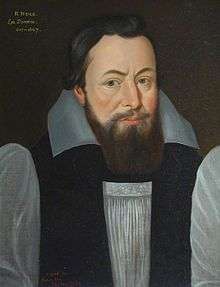 Richard Neile Richard Neile |
Translated from Lincoln, later translated to Winchester. |
| 1627 | 1628 |  George Montaigne George Montaigne |
Translated from London, later translated to York. |
| 1628 | 1632 |  John Howson John Howson |
Translated from Oxford |
| 1632 | 1659 |  Thomas Morton Thomas Morton |
Translated from Lichfield. |
| 1660 | 1672 | 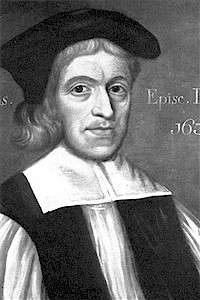 John Cosin John Cosin |
|
| 1674 | 1722 |  Nathaniel Crew Nathaniel Crew |
Translated from Oxford. |
| 1722 | 1730 | 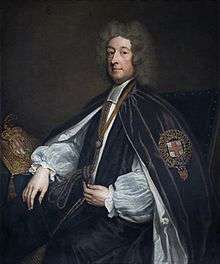 William Talbot William Talbot |
Translated from Salisbury. |
| 1730 | 1750 |  Edward Chandler Edward Chandler |
Translated from Lichfield. |
| 1750 | 1752 |  Joseph Butler Joseph Butler |
Translated from Bristol. |
| 1752 | 1771 |  Richard Trevor Richard Trevor |
Translated from St David's. |
| 1771 | 1787 |  John Egerton John Egerton |
Translated from Lichfield. |
| 1787 | 1791 | |
Translated from Lincoln. |
| 1791 | 1826 |  Shute Barrington Shute Barrington |
Translated from Salisbury. |
| 1826 | 1836 |  William Van Mildert William Van Mildert |
Translated from Llandaff. |
| Source(s):[8] | |||
Late modern bishops (since 1836)
| Bishops of Durham | |||
|---|---|---|---|
| From | Until | Incumbent | Notes |
| 1836 | 1856 |  Edward Maltby Edward Maltby |
Translated from Chichester. |
| 1856 | 1860 |  Charles Longley Charles Longley |
Translated from Ripon, later translated to York, then to Canterbury. |
| 1860 | 1861 |  Henry Villiers Henry Villiers |
Translated from Carlisle. |
| 1861 | 1879 | 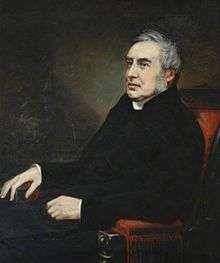 Charles Baring Charles Baring |
Translated from Gloucester and Bristol. |
| 1879 | 1889 |  Joseph Lightfoot Joseph Lightfoot |
Previously Lady Margaret's Professor of Divinity. |
| 1890 | 1901 | 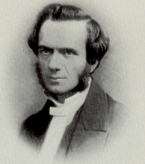 Brooke Westcott Brooke Westcott |
Previously Regius Professor of Divinity at Cambridge. |
| 1901 | 1920 |  Handley Moule Handley Moule |
Previously Norrisian Professor of Divinity. |
| 1920 | 1939 |  Hensley Henson Hensley Henson |
Translated from Hereford. |
| 1939 | 1952 | |
Translated to Winchester. |
| 1952 | 1956 |  Michael Ramsey Michael Ramsey |
Translated to York, then to Canterbury. |
| 1956 | 1966 | |
Translated from Lincoln. |
| 1966 | 1972 |  Ian Ramsey Ian Ramsey |
Previously Nolloth Professor in the Philosophy of Christian Religion at Oxford University. |
| 1973 | 1983 | .jpg) John Habgood John Habgood |
Translated to York. |
| 1984 | 1994 | |
Previously Professor of Theology University of Leeds |
| 1994 | 2003 | |
Translated from Rochester |
| 2003 | 2010 | |
Previously Dean of Lichfield; returned to academia. |
| 2011 | 2013 | .jpg) Justin Welby Justin Welby |
Translated to Canterbury.[9] |
| 2014 | incumbent | |
Previously Bishop of Southwell and Nottingham.[10] |
| Source(s):[8] | |||
References
- ↑ Archbishop of York – Bishop of Durham Election Confirmed (Accessed 20 January 2014)
- ↑ "Positive Developments at Auckland Castle". Retrieved 18 August 2012.
- ↑ "Our Plans". Archived from the original on 27 September 2012. Retrieved 18 August 2012.
- ↑ Keynes, Atlas, Table XXXVII
- ↑ Molyneaux 2015, p. 30.
- ↑ Herbermann, Charles, ed. (1913). "Ancient Diocese and Monastery of Lindisfarne". Catholic Encyclopedia. New York: Robert Appleton.
- ↑ Fryde et al. 2003, pp. 214–215 and 219.
- 1 2 3 4 "Historical successions: Durham (including precussor offices)". Crockford's Clerical Directory. Archived from the original on 19 June 2015. Retrieved 17 July 2012.
- ↑ Diocese of Durham – New Bishop Announced
- ↑ "Election of Paul Butler as 74th Bishop of Durham confirmed in service". Retrieved 20 January 2014.
Sources
- Fryde, E. B.; Greenway, D. E.; Porter, S.; Roy, I., eds. (1986). Handbook of British Chronology (3rd, reprinted 2003 ed.). Cambridge: Cambridge University Press. ISBN 0-521-56350-X.
- Keynes, Simon. "Table XXXVII: Attestations of ecclesiastics during the reign of King Æthelstan" (PDF). Kemble: The Anglo-Saxon Charters Website.
- Molyneaux, George (2015). The Formation of the English Kingdom in the Tenth Century. Oxford University Press. ISBN 978-0-19-871791-1.
- Fryde, E. B.; Greenway, D. E.; Porter, S.; Roy, I., eds. (1986). Handbook of British Chronology (3rd, reprinted 2003 ed.). Cambridge: Cambridge University Press. pp. 216, 241–243. ISBN 0-521-56350-X.
- Greenway, D. E. (1971). "Bishops of Durham". Fasti Ecclesiae Anglicanae 1066–1300: Volume 2: Monastic Cathedrals (Northern and Southern Provinces). British History Online. pp. 29–32.
- Jones, B. (1963). "Bishops of Durham". Fasti Ecclesiae Anglicanae 1300–1541: Volume 6: Northern Province (York, Carlise and Durham). British History Online. pp. 107–109.
- Horn, J. M.; Smith, D. M.; Mussett, P. (2004). "Bishops of Durham". Fasti Ecclesiae Anglicanae 1541–1857: Volume 11: Carlisle, Chester, Durham, Manchester, Ripon, and Sodor and Man Dioceses. British History Online. pp. 73–77.